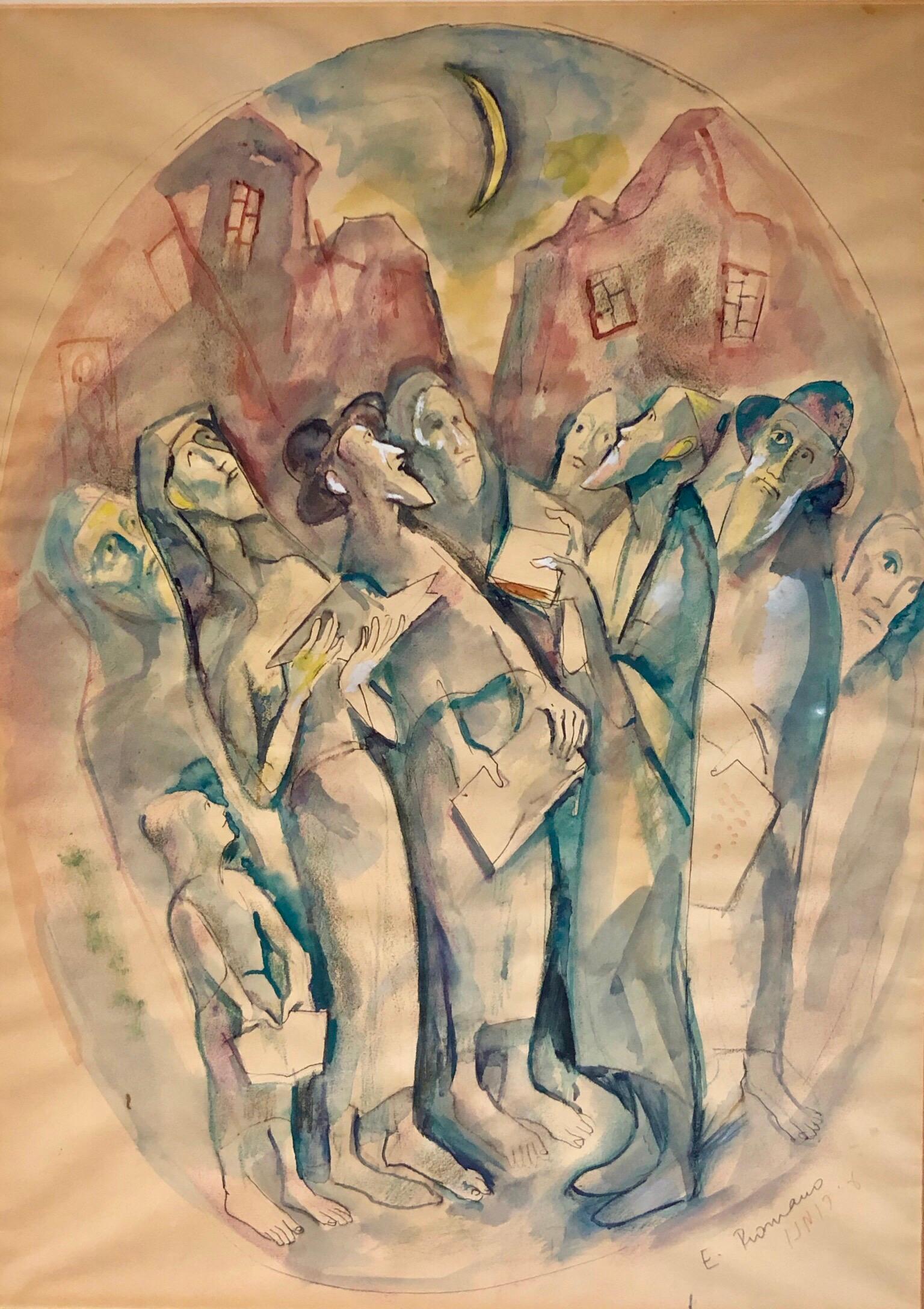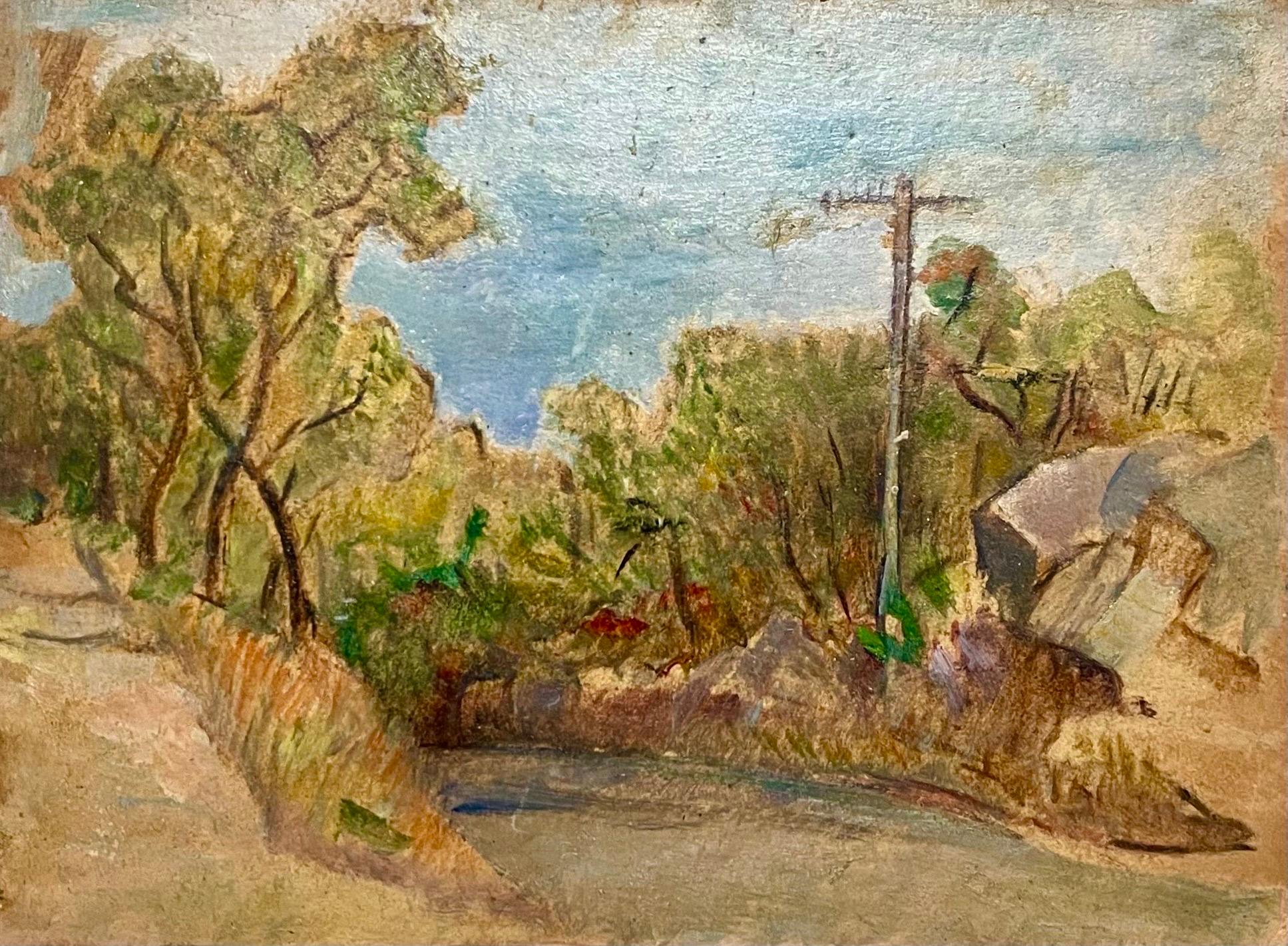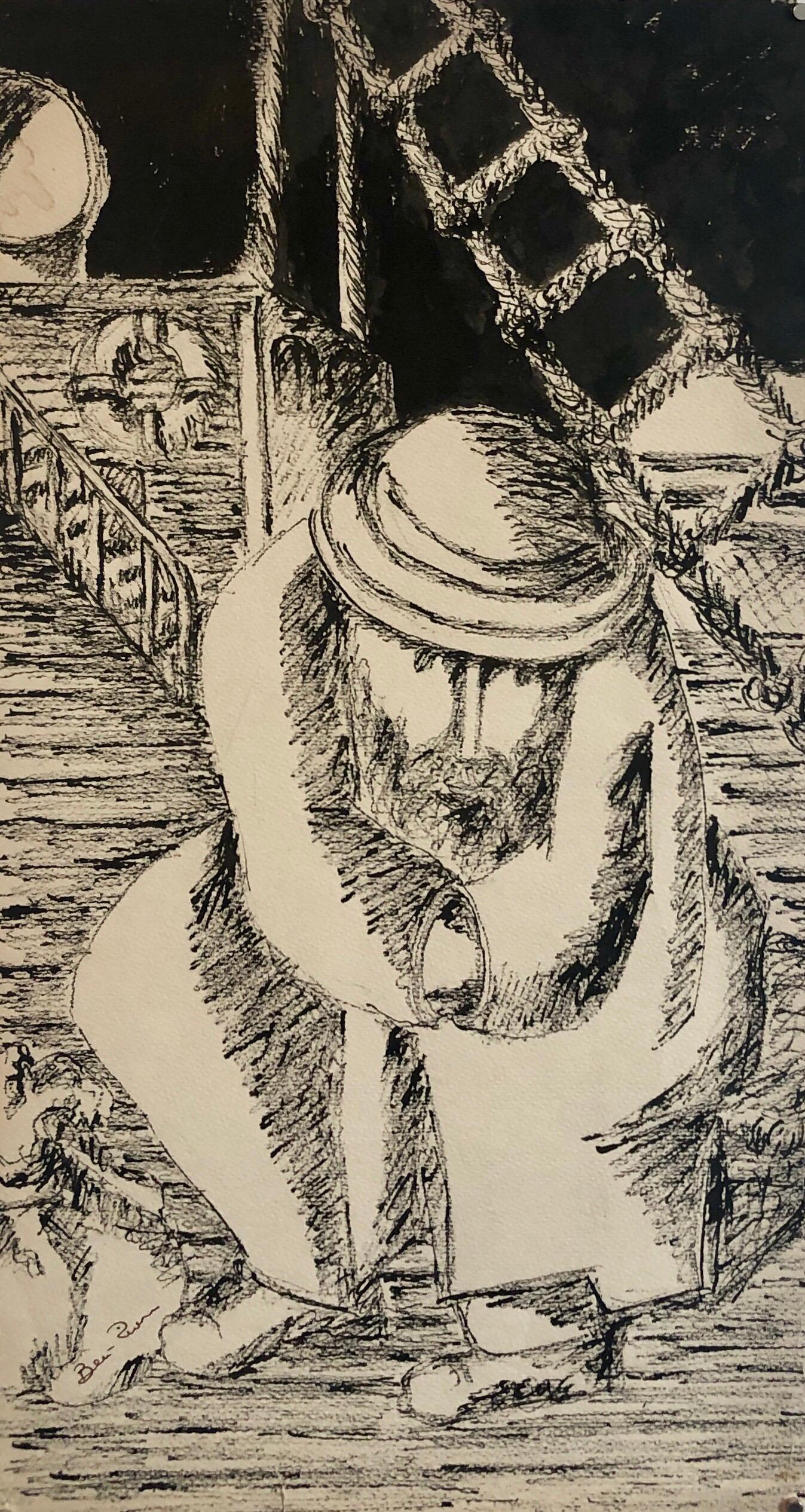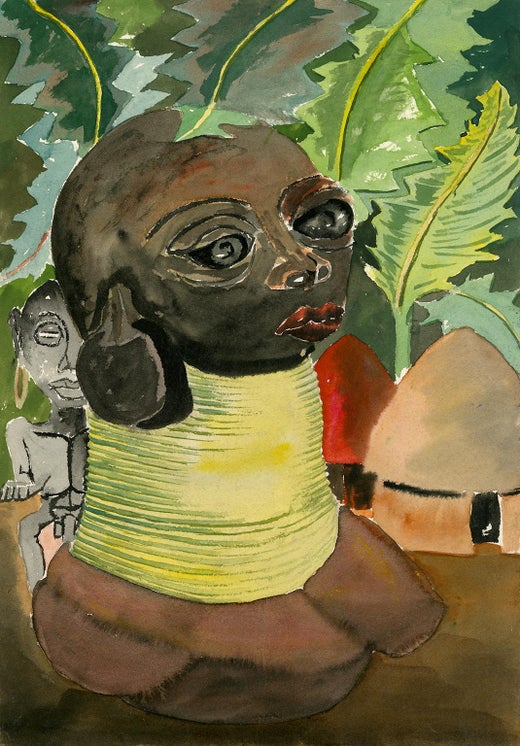Charles Elmer Harris'6th City Wire Works' — Mid-Century African-American Artistc. 1950s
c. 1950s
About the Item
- Creator:
- Creation Year:c. 1950s
- Dimensions:Height: 15 in (38.1 cm)Width: 21.75 in (55.25 cm)
- Medium:
- Movement & Style:
- Period:
- Condition:
- Gallery Location:Myrtle Beach, SC
- Reference Number:
Charles Elmer Harris
Charles Elmer Harris or Beni E. Kosh was born in Cleveland, Ohio. In the 1960s, he legally changed his name to Beni E. Kosh, which translates to the son of Ethiopia. He was a student of Cleveland artist Paul Travis at the Cleveland Institute of Art and later connected to the Sho-Nuff Art Group, a group of African-American artists and the Karamu House artist group, which was a center for artists, writers, dancers and the oldest African-American theater in the United States. Kosh rarely exhibited or sold his work and it was not until after his death that his stylistically diverse oeuvre was rediscovered to receive critical recognition. Kosh’s work is noted in the catalog Yet Still, We Rise: African American Art in Cleveland 1920–1970 and included in exhibitions at the Cleveland State University and the Butler Institute of American Art.
- ShippingRetrieving quote...Ships From: Myrtle Beach, SC
- Return PolicyA return for this item may be initiated within 7 days of delivery.
- 'Dockside' — Mid-Century ModernismBy Alex MinewskiLocated in Myrtle Beach, SCAlex Minewski, 'Dockside', gouache on paper, 1953. Signed in the image, lower left. Annotated 'April 1953, Minewski, ‘Dock Side’, verso. A fine, modernist re...Category
1950s American Modern Figurative Paintings
MaterialsGouache
- 'African Idol' — Mid-Century African-American artistBy Charles Elmer HarrisLocated in Myrtle Beach, SCCharles Elmer Harris (Beni E. Kosh), Untitled (African Idol), watercolor, c. 1950s. Estate stamped verso, 'Beni E Kosh COLLECTION' and numbered '570' in ink. A fine, spontaneous wat...Category
1950s American Modern Figurative Paintings
MaterialsWatercolor
- 'Central Railroad' — Mid-Century African-American ArtistBy Charles Elmer HarrisLocated in Myrtle Beach, SCCharles Elmer Harris (Beni E. Kosh), Untitled (Central Railroad), watercolor, c. 1945. Estate stamped verso, 'Beni E Kosh COLLECTION' and numbered '697' in ink. A fine, modernist re...Category
1940s American Modern Abstract Paintings
MaterialsWatercolor, India Ink
- Variation 4, Vol. IBy Katherine Sophie DreierLocated in Myrtle Beach, SCKatherine S. Dreier, 'Variation 4, Vol. I' from '1 to 40 Variations', lithograph with pochoir and hand-coloring, 1934, edition 65. Stenciled signature and date, lower right. Annotate...Category
Mid-20th Century American Modern Abstract Prints
MaterialsWatercolor, Lithograph, Stencil
- 'Variation 5, Vol. I' — from the series '1 to 40 Variations'By Katherine Sophie DreierLocated in Myrtle Beach, SCKatherine S. Dreier, 'Variation 5, Vol. I' from '1 to 40 Variations', lithograph with pochoir and hand-coloring, 1934, edition 65. Stenciled signature and date, lower right. Annotate...Category
Mid-20th Century American Modern Abstract Prints
MaterialsWatercolor, Lithograph, Stencil
- Woodland Reflection — Mid-Century ModernLocated in Myrtle Beach, SCIrving Lehman, Untitled (Woodland Reflection), watercolor, c. 1955. Unsigned, with the artist's estate stamp verso: 'Original Artwork By: IRVING G. LEHMAN Russian/American 1900-1982'...Category
Mid-20th Century American Modern Abstract Drawings and Watercolors
MaterialsWatercolor
- Suzanna and the EldersBy Ben ShahnLocated in Miami, FLA modern interpretation of the biblical story Suzanna and the Elders. Signed lower right Ink and wash on paper The Downtown Gallery Felix Landau Gallery Ernest Brown & Phillips, Ltd...Category
1940s American Modern Portrait Paintings
MaterialsWatercolor, Ink, Gouache, Archival Paper
- Modernist Watercolor Painting Judaica Kiddush Levana Blessing New MoonBy Emanuel Glicenstein RomanoLocated in Surfside, FLGenre: Judaic prayer scene Subject: Landscape Medium: watercolor Surface: Paper Country: United States EMANUEL ROMANO Rome, Italy, b. 1897, d. 1984 Emanuel Glicenstein Romano was born in Rome, September 23, 1897. His father Henryk Glicenstein was a sculptor and was living in Rome with his wife Helena (born Hirszenberg) when Emanuel was born his father obtained Italian citizenship and adopted the name Enrico. Emanuel was brought up in Italy, Switzerland, Germany, England and Poland. In 1926 Emanuel and his father sailed for New York. They briefly visited Chicago. Romano's sister, Beatrice, and mother only joined them in New York years later. Romano changed his name on his arrival to America and some have erroneously speculated that this was to avoid antisemitic anti Jewish discrimination. In truth, as the son of a highly-regarded artist, Romano changed his name to ensure that any success or recognition he would later attain, would be the result of nothing other than his own merit as an artist, and not on account of his father's fame. In 1936 Romano was worked for the Federal Art Project creating murals. During and immediately after World War II, Romano created a series of allegorical works depicting graphic holocaust images that were held closely by the family until after his passing. One of these works is now on permanent display in the Florida Holocaust Museum in St. Petersburg Florida. Emanuel's father died in 1942 in a car accident before they could realize their shared dream of visiting Israel. In 1944 Romano, having completed his degree at the Pennsylvania Academy of Fine Arts and the Art Institute of Chicago, began teaching at the City College of New York. Romano moved to Safed, Israel in 1953 and established an art museum in his father's memory, the Glicentein Museum. COLLECTIONS Indianapolis Museum of Art Metropolitan Museum of Art Boston Fine Arts Museum Fogg Museum Musée Nacional de France Recently his work has been added to the Florida Holocaust Museum collection. His notable works include his holocaust themed allegorical paintings as well as portraits of Marianne Moore, his father and William Carlos Williams...Category
20th Century American Modern Figurative Paintings
MaterialsPaper, Watercolor
- Simka Simkhovitch WPA Artist Oil Painting Gouache American Modernist PowerlineBy Simka SimkhovitchLocated in Surfside, FLSimka Simkhovitch (Russian/American 1893 - 1949) This came with a small grouping from the artist's family, some were hand signed some were not. These were studies for larger paintings. Simka Simkhovitch (Симха Файбусович Симхович) (aka Simka Faibusovich Simkhovich) (Novozybkov, Russia May 21, 1885 O.S./June 2, 1885 N.S.—Greenwich, Connecticut February 25, 1949) was a Ukrainian-Russian Jewish artist and immigrant to the United States. He painted theater scenery in his early career and then had several showings in galleries in New York City. Winning Works Progress Administration (WPA) commissions in the 1930s, he completed murals for the post offices in Jackson, Mississippi and Beaufort, North Carolina. His works are in the permanent collections of the Dallas Museum of Art, the National Museum of American Art and the Whitney Museum of American Art. Born outside Kyiv (Petrograd Ukraine) into a Jewish family who owned a small department store. During a severe case of measles when he was seven, Simcha Simchovitch sketched the views outside his window and decided to become an artist, over his father's objections. Beginning in 1905, he studied at the Grekov Odessa Art School and upon completion of his studies in 1911 received a recommendation to be admitted to the Imperial Academy of Arts. Though he enrolled to begin classes in architecture, painting, and sculpture at the Imperial Academy, he was dropped from the school roster in December because of the quota on the number of Jewish students and drafted into the army. Simchovitch served as a private in the 175th Infantry Regiment Baturyn [ru] until his demobilization in 1912. Re-enrolling in the Imperial Academy, he audited classes. Simka Simkhovitch exhibited paintings and sculptures in 1918 as part of an exhibition of Jewish artists and in 1919 placed 1st in the competition "The Great Russian Revolution" with a painting called "Russian Revolution" which was hung in the State Museum of Revolution. In 1922, Simkha Simkhovitch exhibited at the International Book Fair in Florence (Italian: Fiera Internazionale del Libro di Firenze). In 1924, Simkhovitch came to the United States to make illustrations for Soviet textbooks and decided to immigrate instead. Initially he supported himself by doing commercial art and a few portrait commissions. In 1927, he was hired to paint a screen for a scene in the play "The Command to Love" by Fritz Gottwald and Rudolph Lothar which was playing at the Longacre Theatre on Broadway. Art dealers began clamoring for the screen and Simkhovitch began a career as a screen painter for the theater. Catching the attention of the screenwriter, Ernest Pascal, he worked as an illustrator for Pascal, who then introduced him to gallery owner, Marie Sterner. Simkhovitch's works appeared at the Marie Sterner Gallery beginning with a 1927 exhibit and were repeated the following year. Simkhovitch had an exhibit in 1929 at Sterner's on circus paintings. In 1931, he held a showing of works at the Helen Hackett Gallery, in New York City and later that same year he was one of the featured artists of a special exhibit in San Francisco at the California Palace of the Legion of Honor in Lincoln Park. The exhibit was coordinated by Marie Sterner and included four watercolors, including one titled "Nudes". He is of the generation of Russian Soviet artists such as Isaac Pailes, Serge Charchoune, Marc Chagall, Chana Orloff, Isaac Ilyich Levitan, and Ossip Zadkine. In 1936, Simkhovitch was selected to complete the mural for the WPA Post office project in Jackson, Mississippi. The mural was hung in the post office and courthouse in 1938 depicted a plantation theme. Painted on the wall behind the judge’s bench, “Pursuits of Life in Mississippi”, a depiction of black workers engaged in manual labor amid scenes of white professionals and socialites, was eventually covered over in later years during renovations due to its stereotypical African American imagery. Simka painted what he thought was typical of Jackson. His impression of pre-civil rights Mississippi was evidently Greek Revival column houses, weeping willow trees, working class families, and the oppression of African Americans. He painted African American men picking cotton, while a white man took account of the harvest and a white judge advised a white family, calling it Pursuits of Life in Mississippi. Though clearly endorsed by the government and initially generally well-received, the mural soon raised concerns with locals as the climate toward racial segregation began to change. The main concern was whether depictions that show African Americans in subjugated societal roles should be featured in a courtroom. The following year, his painting "Holiday" won praise at an exhibition in Lincoln, Nebraska. In 1940, Simkhovitch's second WPA post office project was completed when four murals, "The Cape Lookout Lighthouse and the Orville W. Mail Boat", "The Wreck of the Crissie Wright", "Sand Ponies" and "Canada Geese" were installed in Beaufort, North Carolina. The works were commissioned in 1938 and did not generate the controversy that the Jackson mural had. The main mural is "The Wreck of the Crissie Wright" and depicts a shipwreck which had occurred in Beaufort in 1866. "The Cape Lookout Lighthouse and the Orville W. Mail Boat" depicted the lighthouse built in 1859 and the mail boat that was running mail during the time which Simkhovitch was there. The boat ran mail for the area until 1957. "Sand Ponies" shows the wild horses common to the North Carolina barrier islands and "Canada Geese" showed the importance of hunting and fishing in the area. All four murals were restored in the 1990s by Elisabeth Speight, daughter of two other WPA muralists, Francis Speight...Category
1930s American Modern Landscape Paintings
MaterialsGouache, Oil, Board
- Simka Simkhovitch WPA W/C Painting Gouache American Modernist Beach Scene NudeBy Simka SimkhovitchLocated in Surfside, FLSimka Simkhovitch (Russian/American 1893 - 1949) This came with a small grouping from the artist's family, some were hand signed some were not. These were studies for larger paintings. This is a watercolor and gouache beach scene three young men bathing...Category
1930s American Modern Nude Paintings
MaterialsWatercolor, Gouache, Board
- Portrait of an Old Man with Cane, Important Chicago Modernist WPA ArtistBy William S. SchwartzLocated in Surfside, FLPortrait of an Old Man with Cane, by American artist William S. Schwartz, c. 1940, gouache painting, signed l.l, framed. William S. Schwartz (February 23, 1896 – February 10, 1977) was an American artist who lived and worked in Chicago. Schwartz was born in Smorgon in Belarus, then in the Russian Empire in 1896. His parents were Samuel Schwartz and Tauba Reznikoff. At the age of thirteen, he moved to the nearby city of Vilna to attend art school. Four years later, he emigrated to the United States and eventually enrolled in the School of the Art Institute of Chicago. After graduating, he put his art career on hold to concentrate on a budding career as an opera singer. When Schwartz returned to painting, he distinguished himself with dreamy, symbolist works and abstractions that tended to bewilder viewers. He also scandalized conservative audiences with numerous lithographs of nude women. During the Great Depression, Schwartz became an artist on the Federal Art Project (WPA) payroll painting murals. He was one of the seven WPA artists who contributed to a mural at Riccardo's, Schwartz (Music), Malvin Albright (Sculpture), Ivan Alrbight (Drama), Aaron Bohrod (Architecture), Rudolph Weisenborn (Literature), Vincent D’Agostino (Painting), and Ric Riccardo (Dance). In 2002 Chicago philanthropist Seymour H. Persky acquired the murals for his personal collection. Through the WPA, Schwarz received commissions to produce murals in post offices and public spaces. He created his “Americana Series,” a group of four paintings featuring poets, painters, composers and scientists. His Composersdepicts four contemporary musicians, among them, Victor Herbert. The mural was discovered at Glencoe Public Library, IL, in 2007, and include: Americana No. 1 Poets: Mark Twain, Walt Whitman and Edgar Allen Poe; Americana No. 2 Painters: Saint Gaudens, Bellows, Sargent, Innes, Whistler and Homer; Americana No. 3 Composers: Herbert, DeKoven, Chadwick, MacDowel; Americana No. 4 Scientists: Thomas Alva Edison, Steinmetz, Alexander Graham Bell...Category
Mid-20th Century American Modern Figurative Paintings
MaterialsGouache
- Modernist Judaica Jewish Ink Drawing Painting "New Immigrant" Off the Boat WPABy Ben-Zion WeinmanLocated in Surfside, FLAn ink drawing Judaic painting by modern artist Ben-Zion Weinman. It depicts a portrait of an old Jewish man. Coming over from Europe on a ship crossing. The work is signed "Ben-Zion". Born in 1897, Ben-Zion Weinman celebrated his European Jewish heritage in his visual works as a sculptor, painter, and printmaker. Influenced by Spinoza, Knut Hamsun, and Wladyslaw Reymont, as well as Hebrew literature, Ben-Zion wrote poetry and essays that, like his visual work, attempt to reveal the deep “connection between man and the divine, and between man and earth.” An emigrant from the Ukraine, he came to the US in 1920. He wrote fairy tales and poems in Hebrew under the name Benzion Weinman, but when he began painting he dropped his last name and hyphenated his first, saying an artist needed only one name. In 1920 he settled in America, where he found little interest in his writing. He began teaching Hebrew to support himself and then in the early 1930s returned to painting. He used his art to comment on the rise of fascism in Europe, events he felt could not be adequately explored with words. Largely self-taught, Ben-Zion visited the museums of New York City to learn his new trade. His first painting on a large scale, Friday Evening (1933, Jewish Museum, New York), depicts a Sabbath dinner table as recalled from his family home. Ben-Zion supported himself by working odd jobs until the establishment of the Works Progress Administration's Federal Art Project. Under the auspices of the wpa, Ben-Zion thrived and galleries began to show his work. In 1936, after his first one-man show at the Artists' Gallery in New York Ben-Zion was a founding member of “The Ten: An Independent Group” The Ten” a 1930’s...Category
1940s American Modern Figurative Paintings
MaterialsWatercolor, Gouache





